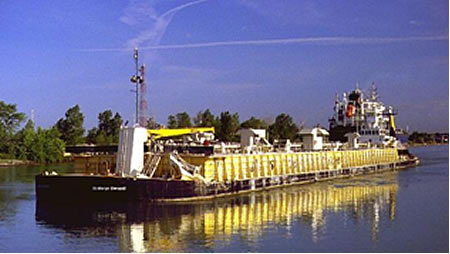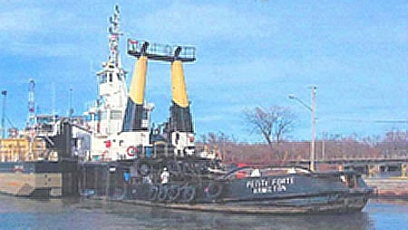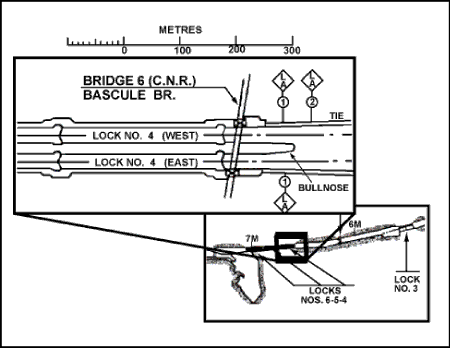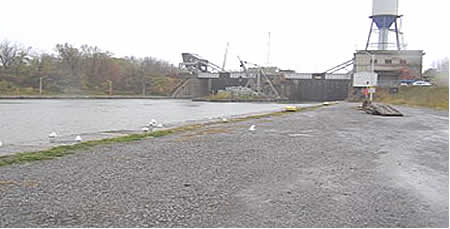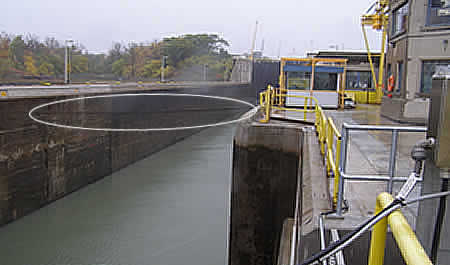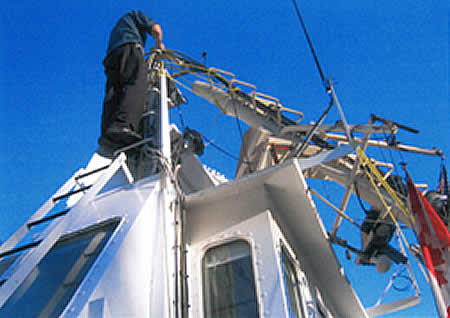Striking of lock arrester cable
Pusher tug Petite Forte and barge St. Marys Cement
Lock 4, Welland Canal, St. Catharines, Ontario
The Transportation Safety Board of Canada (TSB) investigated this occurrence for the purpose of advancing transportation safety. It is not the function of the Board to assign fault or determine civil or criminal liability. This report is not created for use in the context of legal, disciplinary or other proceedings. See Ownership and use of content. Masculine pronouns and position titles may be used to signify all genders to comply with the Canadian Transportation Accident Investigation and Safety Board Act (S.C. 1989, c. 3).
Summary
On 02 October 2006 during twilight at 0615 eastern daylight time, shortly after having cleared the exit of the lock, the downbound tug Petite Forte, pushing the barge St. Marys Cement, drifted backwards and struck the arrester cable in Lock 4 of the Welland Canal. The tug's mast and electronic navigation equipment were damaged. The shear pins and linkage for the lock's ship-arrester cable needed to be replaced.
Factual information
Particulars of vessels
| Name of vessel | Petite Forte | St. Marys Cement |
|---|---|---|
| Official number | 359165 | 8225140 |
| Port of registry | Hamilton, Ontario | Hamilton, Ontario |
| Flag | Canada | Canada |
| Type | Tug | Cement Barge |
| Gross tonnageFootnote 1 | 369.17 | 4679.0 |
| Length | 36.12 m (with push arrangement +.84 m ) | 109.73 m |
| Draught | Forward: 3.66 m Aft: 3.66 m |
Forward: 4.88 m Aft: 4.09 m |
| Built | 1969 | 1986 |
| Propulsion | 2 x 2500 BHP Ruston-Diesels | Bow Thruster 300 BHP |
| Cargo | n/a | Ballast |
| Crew | 9 | None |
| Registered owner | Great Lakes and International Towing & Salvage Company, Inc. | Great Lakes and International Towing & Salvage Company, Inc. |
| Manager | Erie Shore Shipping | Erie Shore Shipping |
Tug and barge description
The tug Petite Forte has an upper and lower wheelhouse. The upper wheelhouse is used more often for navigation when pushing the barge St. Marys Cement, especially when in ballast as it provides better visibility than is possible from the lower wheelhouse.
In pushing mode, the Petite Forte has 38 per cent of its length positioned in the notch of the barge. The tug is connected to the barge by two steel cables so as to prevent tug movement astern. Lateral motion is restricted by side pads with zero clearance between the tug and barge. This renders both vessels a single composite unit approximately 134 m in length (see Photo 1 and Photo 2).
Crewing requirements
The Petite Forte's upper wheelhouse comfortably accommodates one person for navigation purposes but not two. In recognition of this fact, The St. Lawrence Seaway Corporation allows the vessel to meet crewing requirements by allowing one qualified person in each of the upper and lower wheelhouses when the vessel is underway within the confines of the St. Lawrence Seaway.Footnote 2
Description of Lock 4 and adjacent area
Locks 4, 5, and 6 in the Welland Canal section of the St. Lawrence Seaway are dual capability locks that allow vessels to transit simultaneously both upbound and downbound. The last downbound lock of this group is Lock 4. When approaching Lock 4 from Lock 3 (upbound), there is the possibility of hydrodynamic interaction between vessels as the canal narrows towards Lock 4. To prevent this, a 100 m "bullnose" has been constructed. This is a concrete pier that protrudes from the locks (see Figure 1).
A few metres past the Lock 4 gates (when moving downbound towards Lock 3), but well before the tip of the bullnose, lies Canadian National (CN) Rail Bridge No. 6. This is a moveable "Bascule" bridge that can be opened or closed to allow vessels to pass.
History of the voyage
On 01 October 2006, the tug Petite Forte, pushing the barge St. Marys Cement in composite unit, was downbound in Lake Erie en route from Toledo, Ohio, to Bowmanville, Ontario. At 2300Footnote 3, the unit proceeded from Long Point towards Port Colborne and into Lock 8 of the Welland Canal. The master was alone in the tug's upper wheelhouse. The OOW was stationed in the communications area in the forward part of the lower wheelhouse.
At 0538, after passing through Locks 7, 6, and 5, the composite unit entered and was secured in the east chamber of Lock 4.
At 0549, the composite unit was lowered within the lock and at 0600 it was ready to leave the lock. At this point, only its mast showed above the lock's wall.
At 0602, the ship traffic controller, who was concluding his shift, used a very high frequency (VHF) radiotelephone to instruct the Petite Forte to move to the head of the lock area and, once there, to maintain position until the bulk carrier Algomarine, upbound from Lock 3, began entering the west chamber of Lock 4.
The ship traffic controller was then relieved by the controller for the next shift. The two exchanged situational information until approximately 0605.
At 0609, the stern of the tug cleared the Lock 4 gates. A Lock 4 lines person then signalled the lockmaster that the stern of the Petite Forte had cleared both the lock gates and CN Rail Bridge No. 6. Procedures were then initiated to turn back the lock in preparation for the next downbound vessel (see the section titled Lock 4 - Normal Operating Procedures).
At 0611, the ship-arrester cable was lowered across the east chamber's lock entrance, astern of the Petite Forte.
In keeping with normal practice, there was no VHF communication with the Petite Forte by either the Lock 4 lock operatorFootnote 4 or Seaway traffic control to say that the arrester cable had been lowered (see Photo 5), nor was such communication required.
At this time the composite unit was at the head of the lock area with the tug's stern approximately 10 m beyond the Lock 4 gates. In accordance with lock procedures, the Lock 4 Seaway personnel stopped spotting the tug and shifted their attention to the west side (upbound) section of the lock in preparation for the Algomarine's arrival.
While the composite unit was holding its position at the head of the lock, the Algomarine's approach created a surge of water that raised the water level by 5 cm. The force of this surge pushed the composite unit astern, towards the chamber it had just left.
At 0612, the new ship traffic controller could see on a monitor that the composite unit was drifting astern into the lock. The controller informed the Petite Forte via VHF radiotelephone that it had been instructed to hold position inside the east chamber until the Algomarine entered the west chamber, along with a reminder that the tug was to do this in the future.
Although this contradicted the original instruction to proceed to the head of the lock area and hold position, the master neither questioned nor challenged the new ship traffic controller's comment. He did not ask for clarification. Instead, the master interpreted the comment as a change of instructions. He was thus unconcerned when the composite unit began to drift astern, back into the lock.
At 0613, the master indicated to Seaway traffic control that he was stopping his vessel and would wait for the Algomarine to arrive in the west chamber of Lock 4. A Seaway traffic control video playback shows that the tug continued to move astern.
At 0615, while drifting astern with the water surge, the tug's mast struck the ship-arrester cable. The impact buckled the mast and disabled most of the electronic navigation and communication equipment. The arrester cable's connecting link attachments, as well as the mechanical/spring buffer system, were also damaged.
After an initial damage survey and inspection by Seaway and Transport Canada inspectors, the tug was cleared for transit to Wharf 1 for repairs.
Head of the lock
Whenever another large vessel, such as a bulk carrier, approaches upbound towards Lock 4, Seaway traffic control instructs any vessel departing Lock 4 downbound not to proceed much beyond the head of the lock area and, once there, to hold its position.
The term, although not specifically defined, applies to an approximate area from the lock chamber gates up to and including the tip of the bullnose, but not usually beyond the point L/A2 (Limit of Approach 2), which is approximately 25 to 30 m beyond the bullnose (see Figure 1). In practice and for the Lock 4 area, the term is generally taken to mean that a vessel's bow be positioned outside of the open lock gate doors and near or slightly forward of the tip of the bullnose. The position for the head of the lock will change from lock to lock according to lock construction variations and Seaway traffic control instructions.
Depending on overall length, it is also possible for a vessel to be located at the head of the lock and yet remain partially within the lock chamber.
In this occurrence, the stern of the Petite Forte was approximately 10 m beyond the lock gates, the majority of its length was back of the bullnose, and its bow was some distance beyond the tip - possibly slightly past L/A2. Such a position would be considered within the head of the lock area for this lock.
Lock 4 - Normal operating procedures
When the water in the east chamber reaches its maximum level, the lock is considered filled. Before a downbound vessel enters, the forward arrester cable is lowered and locked in place, transversely across the lock, so as to prevent the vessel's bow from striking the forward lock gate. After linespersons secure the vessel, the rear ship-arrester cable is lowered into place behind the vessel. The water in the chamber is then releasedFootnote 5 and the vessel is lowered (approximately 13 m in the case of Lock 4).
At this point the gates are opened, the forward arrester cable is raised, the vessel's mooring lines are let go, and the vessel begins moving ahead towards the lock exit according to any instructions given by Seaway traffic control. If there is no upbound vessel approaching from Lock 3, the downbound vessel can proceed without restriction. If there is, however, then the downbound vessel will be instructed by Seaway traffic control to hold position at the head of the lock.Footnote 6
The purpose of waiting in this area is so that the downbound vessel will still have the protection of the bullnose "buffer" and thus avoid the possibility of hydrodynamic interaction that could otherwise take place with two large vessels transiting in opposite directions in such an enclosed space. The bullnose also protects against the water surge created by an upbound vessel which can cause a downbound stationary vessel to drift astern.Footnote 7 Typically, a downbound vessel waiting at the head of the lock will remain there until the majority of the oncoming upbound vessel's length has passed into the opposite chamber.
Once the downbound vessel fully clears the lock chamber, the arrester cable is lowered again (for the next vessel) and the lock gates are closed. Neither Seaway traffic control nor the lock operators inform a departing vessel that these lock preparation procedures have begun. Seaway personnel also stop spotting a vessel at this point, shifting their attention to any vessel approaching the upbound section of the lock.
Weather
The area weather recorded by Environment Canada for 02 October 2006, at 0600, indicated clear visibility under cloud cover and light winds from the south-southwest at six knots.
Personnel certification
The master had a Foreign-Going Master's certificate and had been working with this company for 10 years, the last seven as master. He averaged 40 to 45 trips through the Welland Canal per year and he was well-versed with canal operations.
Communications
The Seaway traffic control centre communicates with shipping traffic on VHF channel 14, in addition to monitoring channel 16. The Seaway traffic control centre for this section of the seaway is located near Locks 4, 5, and 6.Footnote 8 The lockmaster at Lock 4 communicates with vessels separately on channel 66A and channel 17 for Lock 4 east and west, respectively. Communications on these latter two channels are generally not monitored by Seaway traffic control. Lock personnel use a conventional "land line" to communicate with Seaway traffic control.
At the time of the occurrence, neither Seaway traffic control nor Lock 4 VHF communication channels were used - nor were they required to be used - to inform the master of the Petite Forte that the ship arrester had been lowered.
Damage to vessel
The Petite Forte suffered damage to its main mast, which was sheared-off at the deck. All the electronic navigation and communication equipment was rendered non-operational including the following: radars, DGPS unit, navigational lights, anchor release antennae, and radio antennae (see Photo 6).
Damage to the arrester cable
The shear pins and linkage for Lock 4's arrester cable were broken.Footnote 9
Analysis
Head of the lock
The St. Lawrence Seaway Authority has not specifically defined the term "head of the lock" in its Seaway Handbook, with the result that masters/pilots may adapt its meaning slightly differently to suit their own judgment or understanding.
Although it is possible for large vessels (most Great Lakes bulk carriers are over 200 m) to have their bow near the tip of the bullnose or even slightly past the point L/A2 (Limit of Approach 2) and yet have their stern remain well inside the lock chamber, this was not the case with the 134 m composite unit. Although the unit's bow may have slightly exceeded L/A2, its stern was 10 m outside the lock gates. The instruction to proceed to the head of the lock - and the subsequent comment that the vessel had been instructed to remain within the lock - were contradictory.
Moreover, the master of the Petite Forte had been traversing the Welland Canal as a master on many voyages in the previous seven years and had covered this route many times. He was familiar with the term and in this occurrence proceeded to go to a position he had taken on previous occasions when given the same instruction. However, he failed to question the second, contradictory, comment from the traffic controller that the vessel had been instructed to remain in the lock.
Without a specific definition for the head of the lock, pilots/masters may position their vessels at risk.
Lock operations
Vessel monitoring
After the line-handlers at Lock 4 let go of the composite unit, they tracked the vessel's stern as it moved downbound, beyond the lock gates and CN Rail Bridge No. 6. The bridge remained open and the line handlers began to focus their attention on the incoming vessel, Algomarine, which was approaching the lock's west chamber.
Because the stern of the tug-barge unit was now located approximately 10 m outside the lock gates and beyond the open bridge, lock personnel, having advised traffic control that the tug/barge unit had cleared Lock 4, were not required to communicate further with the tug. In preparing to receive the next vessel into the lock, lock personnel lowered the arrester cable behind the tug-barge unit. However, the Petite Forte master was not informed of this event, nor was there an official requirement for Seaway Welland to do so. With their attention now shifted to the west chamber and the approaching Algomarine, lock personnel did not monitor the movement of the tug and barge when it began to move astern, towards the arrester cable. Discontinued spotting of the vessel and lowering the arrester cable without informing the master precluded him from positioning his vessel safely.
Communications
At 0602, the initial controller had instructed the Petite Forte to proceed to the head of the lock and hold position. At 0612, the new controller, who had just completed an information exchange with the previous controller prior to beginning his shift, issued a new comment - that the vessel had been instructed to hold position inside the east chamber until the Algomarine entered the west chamber, along with a reminder to do so in the future. This new comment contradicted the original controller's instruction to proceed to the head of the lock.
The first traffic controller's instruction set in motion a number of events, namely the composite unit proceeding from inside the lock chamber to the head of the lock, Lock 4 personnel shifting their attention towards the Algomarine, and the lowering of the arrester cable astern of the Petite Forte.
Masters/pilots on vessels entering or leaving locks require clear and unambiguous instructions as to where they may safely position their vessels. In this instance, the comment from the new ship traffic controller to the tug's master contradicted the previous instruction. The master, however, did not seek to clarify the apparent contradictory statements of the two controllers and the vessel continued to drift astern without being apprised of the situation.
Crewing requirements/lookout
The St. Lawrence Seaway Corporation permits this vessel to have only one qualified person in the upper wheelhouse, provided a second qualified person is stationed in the lower wheelhouse.
However, the visibility astern from that lower wheelhouse was limited and the lowered arrester cable difficult to see, particularly at night. Consequently, the vessel was without the benefit of an efficient lookout in that location as intended by the Seaway Corporation's dispensation.
Arrester cable visibility
Photo 5, taken in daylight, shows the arrester cable as difficult to see against the background of Lock 4. In darkness, when the area was lit by shore-side floodlights, the difficulty increased particularly since the cable was cast in partial shadow. The shore-side lighting and restricted view from the lower wheelhouse made the arrester cable difficult to detect.
Findings
Findings as to causes and contributing factors
- Discontinued spotting of the vessel and lowering the arrester cable without informing the master precluded him from positioning his vessel safely.
- The master allowed the vessel to drift astern and contact the arrester cable because he was unaware that it had been lowered.
- The shore-side lighting and restricted view from the lower wheelhouse made the arrester cable difficult to detect.
- The final instructions received from Seaway Control suggested that movement astern was not inappropriate.
Findings as to risk
- Without a specific definition for the term "head of the lock", pilots/masters may position their vessels at risk.
Safety action
Action taken
St. Lawrence Seaway Management Corporation
Following this occurrence, the St. Lawrence Seaway Management Corporation instructed lock operators that vessels are to be informed when the arrester cable has been lowered or when the lock preparation cycle has begun.
Additionally, the St. Lawrence Seaway Management Corporation has since covered arrester cables with a fluorescent yellow wrap to make them more visible for spotting purposes.
A new procedure has been adopted that addresses lock responsibility regarding monitoring vessels which have been dispatched to "hold at the head of the lock."
This report concludes the Transportation Safety Board's investigation into this occurrence. Consequently, the Board authorized the release of this report on .
